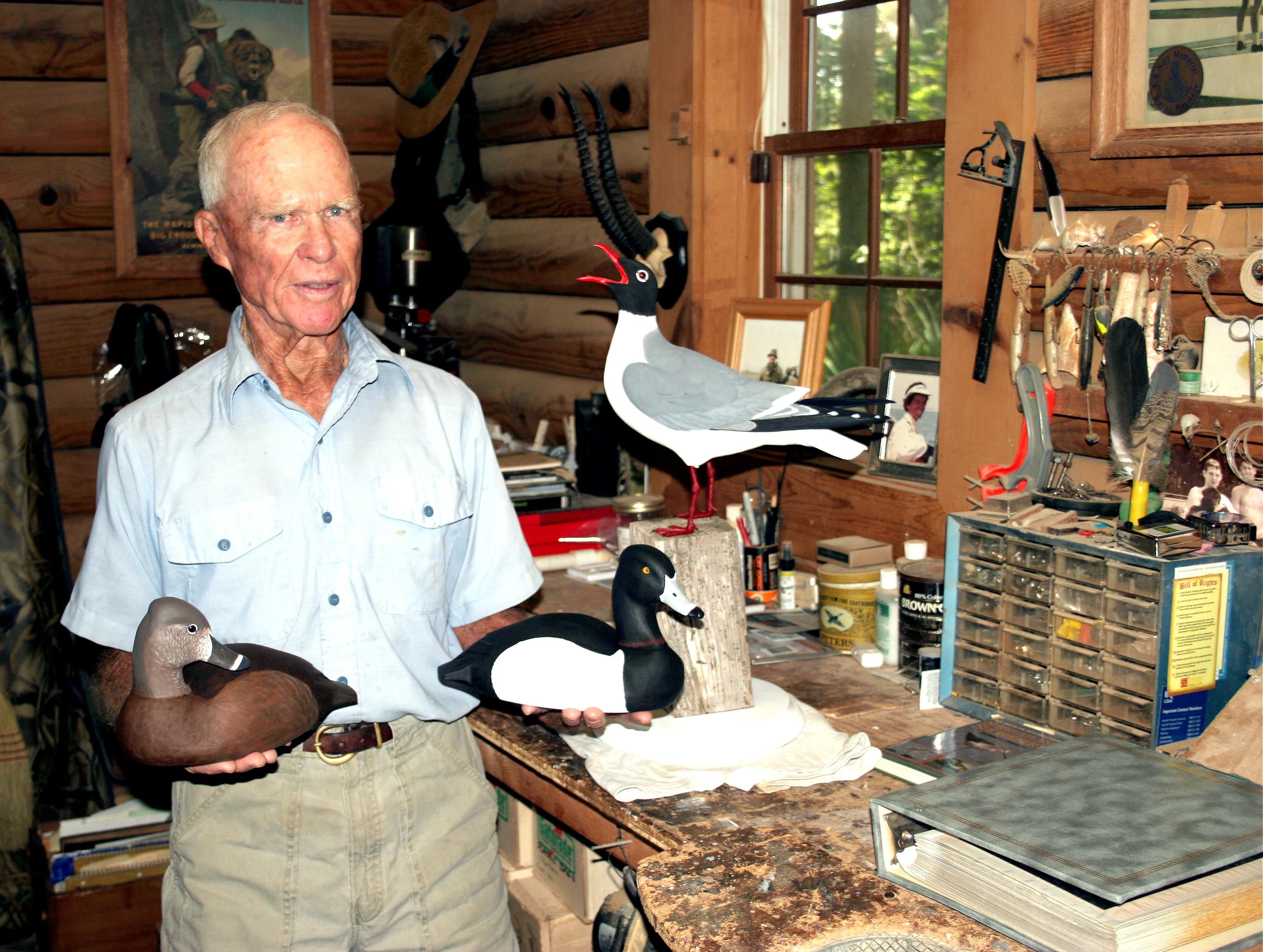Wood Birds Like The Real Thing
Bob McNally 03.30.16

Whit Whitlock is the consummate commander. Maybe not commander-in-chief, but on his St. Augustine, Florida charter boat “Black Hawk,” it’s fishing his way, or no way. This comes as a result of over 25-years as a Navy destroyer commander, headquartered in Mayport.
Whit, age 60ish and a Princeton graduate, retired from the Navy in 1974. Four years later he jumped at saltwater fishing in a big way, becoming a tarpon charter captain first and foremost, and a good one. He catches silver kings large and strong, and for over 30 years has lead countless anglers to heavyweight tarpon from his spotless and impeccably-cared for Shamrock “Black Hawk,” a 20-foot keel drive model. But saltwater fishing in Northeast Florida is seasonal, particularly for tarpon, Whit’s passion. So to help fill in time between fishing strikes, Whit returned to a New Jersey boyhood pastime–whittling.
With his meticulous eye for detail and love of the outdoors, Whit was quick to turn out some remarkable bird carvings from his home shop built along a wild and wonderful stretch of coastal oak hammock north of St. Augustine, near Palm Valley. It is a place where he has hunted ducks and has observed a staggering array of wildlife, chiefly birds, which have become subjects for his whittling.
But to call Whit’s wooden creations “whittling” is a little like saying Hemmingway “scribbled” his musings and Rembrandt “dabbled” in oils. This untrained artist has an eye for detail that only comes from a lifetime outdoors and a heartfelt love for everything around it. His delicate carvings of bird wings, beaks, bills, tapering feathered heads, and airborne-predator eyes that glow with the passion of life are something to behold.
While Whit has carved fish and some exotic birds, most of his carvings are of waterfowl, or at least wild, marsh-borne birds. “Almost everyone likes a nice carving of a wood duck or teal, and that’s a pretty easy to sell a wife or girlfriend,” Whit says laughing. “But a brook trout or seatrout isn’t as appealing to ladies, and it can be a hard sell at home.
“I once did a commissioned Cooper’s hawk for a man, and his wife was distraught about the ‘mean’ eyes the bird had. “Ma’am,” I explained, “that’s how the eyes of a hunting hawk look. They aren’t quite like a parakeet.”
Most of Whit’s carvings are sold to local collectors in Northeast Florida. It takes about two months for a quality bird carving to be completed for Whit, and many are done on commission. Occasionally he’ll carve a bird because he just wants to do a particular species, like an American kestrel or swallow-tail kite.
“I carve those species for me and worry about selling them later,” he says. “But they always sell, never had a problem selling anything, even when I first started.”
His wife Sarah is Whit’s sales agent, and as a real estate expert, she knows how to sell and is savvy about the market. Early on Whit sold some carvings for what seems now as ridiculously low prices. He now sells items for up to $7,500, in this case an osprey for local businessman Herb Peyton, with its wings wide and mouth agape as it sqwaks loudly.
“Herb ending up commissioning me to do another osprey, but much different from the first,” says Whit. “Both birds are on display at the Ponte Vedra Beach Inn & Club–one in the main room of the club, the other in the convention center.”
Although delicately carving and painting “display” type wildlife art is Whit’s passion and business, he also still carves working decoys for hunters. Most are puddle ducks like teal and woodies, pintails and widgeon, carved from cedar. Though he recently carved a pair of such “working decoys” mimicking ringneck ducks for about $150–considerably less than “display” type carvings.
Tupelo is his wood of choice for carving fine detail, using tools not particularly fancy in today’s carving era. He still uses a pen knife for some carving, though also incorporates band saws, rotary tools, jewelry-making tools, and a feather etcher for burning wood.
Almost all of Whit’s carvings are in motion because he abhors static wildlife. His ducks preen, his hawks have wings spread, his owls have turned heads or talons outstretched. They are simply more lifelike, he explains.
Although self-taught, Whit was inspired to upgrade his craft shortly after retiring from the Navy.
“I went to a local art show and there was a lot of great work by a carver named Joe Drake,” Whit recalls. “His stuff was just outstanding, and I told Sarah that I could do that, too, if I put in the time.”
He has, and his art shows it.


